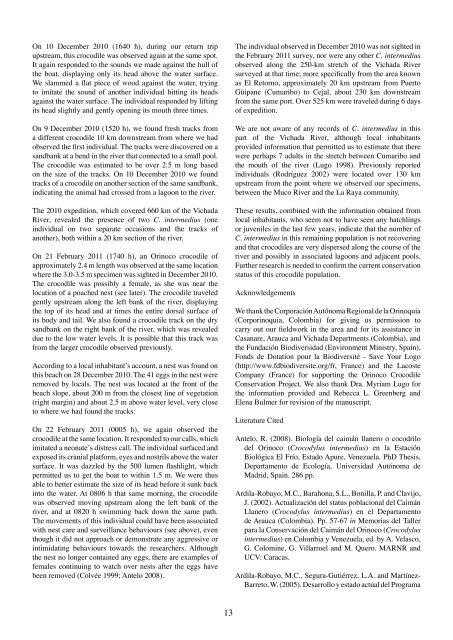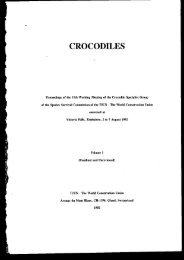size: 992KB - Crocodile Specialist Group
size: 992KB - Crocodile Specialist Group
size: 992KB - Crocodile Specialist Group
You also want an ePaper? Increase the reach of your titles
YUMPU automatically turns print PDFs into web optimized ePapers that Google loves.
On 10 December 2010 (1640 h), during our return trip<br />
upstream, this crocodile was observed again at the same spot.<br />
It again responded to the sounds we made against the hull of<br />
the boat, displaying only its head above the water surface.<br />
We slammed a flat piece of wood against the water, trying<br />
to imitate the sound of another individual hitting its heads<br />
against the water surface. The individual responded by lifting<br />
its head slightly and gently opening its mouth three times.<br />
On 9 December 2010 (1520 h), we found fresh tracks from<br />
a different crocodile 10 km downstream from where we had<br />
observed the first individual. The tracks were discovered on a<br />
sandbank at a bend in the river that connected to a small pool.<br />
The crocodile was estimated to be over 2.5 m long based<br />
on the <strong>size</strong> of the tracks. On 10 December 2010 we found<br />
tracks of a crocodile on another section of the same sandbank,<br />
indicating the animal had crossed from a lagoon to the river.<br />
The 2010 expedition, which covered 660 km of the Vichada<br />
River, revealed the presence of two C. intermedius (one<br />
individual on two separate occasions and the tracks of<br />
another), both within a 20 km section of the river.<br />
On 21 February 2011 (1740 h), an Orinoco crocodile of<br />
approximately 2.4 m length was observed at the same location<br />
where the 3.0-3.5 m specimen was sighted in December 2010.<br />
The crocodile was possibly a female, as she was near the<br />
location of a poached nest (see later). The crocodile traveled<br />
gently upstream along the left bank of the river, displaying<br />
the top of its head and at times the entire dorsal surface of<br />
its body and tail. We also found a crocodile track on the dry<br />
sandbank on the right bank of the river, which was revealed<br />
due to the low water levels. It is possible that this track was<br />
from the larger crocodile observed previously.<br />
According to a local inhabitant’s account, a nest was found on<br />
this beach on 28 December 2010. The 41 eggs in the nest were<br />
removed by locals. The nest was located at the front of the<br />
beach slope, about 200 m from the closest line of vegetation<br />
(right margin) and about 2.5 m above water level, very close<br />
to where we had found the tracks.<br />
On 22 February 2011 (0005 h), we again observed the<br />
crocodile at the same location. It responded to our calls, which<br />
imitated a neonate’s distress call. The individual surfaced and<br />
exposed its cranial platform, eyes and nostrils above the water<br />
surface. It was dazzled by the 500 lumen flashlight, which<br />
permitted us to get the boat to within 1.5 m. We were thus<br />
able to better estimate the <strong>size</strong> of its head before it sunk back<br />
into the water. At 0806 h that same morning, the crocodile<br />
was observed moving upstream along the left bank of the<br />
river, and at 0820 h swimming back down the same path.<br />
The movements of this individual could have been associated<br />
with nest care and surveillance behaviours (see above), even<br />
though it did not approach or demonstrate any aggressive or<br />
intimidating behaviours towards the researchers. Although<br />
the nest no longer contained any eggs, there are examples of<br />
females continuing to watch over nests after the eggs have<br />
been removed (Colvée 1999; Antelo 2008).<br />
The individual observed in December 2010 was not sighted in<br />
the February 2011 survey, nor were any other C. intermedius<br />
observed along the 250-km stretch of the Vichada River<br />
surveyed at that time; more specifically from the area known<br />
as El Retorno, approximately 20 km upstream from Puerto<br />
Güipane (Cumaribo) to Cejal, about 230 km downstream<br />
from the same port. Over 525 km were traveled during 6 days<br />
of expedition.<br />
We are not aware of any records of C. intermedius in this<br />
part of the Vichada River, although local inhabitants<br />
provided information that permitted us to estimate that there<br />
were perhaps 7 adults in the stretch between Cumaribo and<br />
the mouth of the river (Lugo 1998). Previously reported<br />
individuals (Rodríguez 2002) were located over 130 km<br />
upstream from the point where we observed our specimens,<br />
between the Muco River and the La Raya community.<br />
These results, combined with the information obtained from<br />
local inhabitants, who seem not to have seen any hatchlings<br />
or juveniles in the last few years, indicate that the number of<br />
C. intermedius in this remaining population is not recovering<br />
and that crocodiles are very dispersed along the course of the<br />
river and possibly in associated lagoons and adjacent pools.<br />
Further research is needed to confirm the current conservation<br />
status of this crocodile population.<br />
Acknowledgements<br />
We thank the Corporación Autónoma Regional de la Orinoquia<br />
(Corporinoquia, Colombia) for giving us permission to<br />
carry out our fieldwork in the area and for its assistance in<br />
Casanare, Arauca and Vichada Departments (Colombia), and<br />
the Fundación Biodiversidad (Environment Ministry, Spain),<br />
Fonds de Dotation pour la Biodiversité - Save Your Logo<br />
(http://www.fdbiodiversite.org/fr, France) and the Lacoste<br />
Company (France) for supporting the Orinoco <strong>Crocodile</strong><br />
Conservation Project. We also thank Dra. Myriam Lugo for<br />
the information provided and Rebecca L. Greenberg and<br />
Elena Bulmer for revision of the manuscript.<br />
Literature Cited<br />
Antelo, R. (2008). Biología del caimán llanero o cocodrilo<br />
del Orinoco (Crocodylus intermedius) en la Estación<br />
Biológica El Frío, Estado Apure, Venezuela. PhD Thesis,<br />
Departamento de Ecología, Universidad Autónoma de<br />
Madrid, Spain. 286 pp.<br />
Ardila-Robayo, M.C., Barahona, S.L., Bonilla, P. and Clavijo,<br />
J. (2002). Actualización del status poblacional del Caimán<br />
Llanero (Crocodylus intermedius) en el Departamento<br />
de Arauca (Colombia). Pp. 57-67 in Memorias del Taller<br />
para la Conservación del Caimán del Orinoco (Crocodylus<br />
intermedius) en Colombia y Venezuela, ed. by A. Velasco,<br />
G. Colomine, G. Villarroel and M. Quero. MARNR and<br />
UCV: Caracas.<br />
Ardila-Robayo, M.C., Segura-Gutiérrez, L.A. and Martínez-<br />
Barreto, W. (2005). Desarrollo y estado actual del Programa<br />
13

















